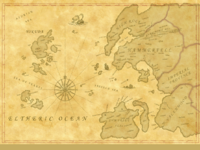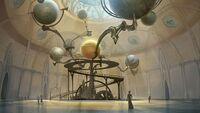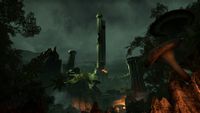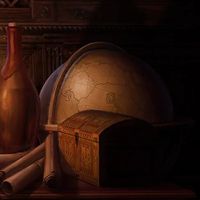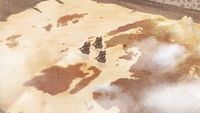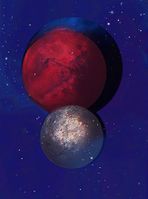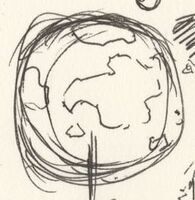Lore:Nirn
| Nirn | |
|---|---|
| Type | Planet |
| Realm | Mundus |
| Demonym(s) | Nirnian |
Nirn (which means 'Gray Maybe' in Ehlnofex),[1][nb 1] or the mortal Aurbis,[1] is the Mortal Plane, the planet upon which Tamriel and the mortal races reside. It floats in the void of Oblivion and comprises the core of the region known as Mundus.[2] Some sources use the terms Nirn and Mundus synonymously, though others describe Mundus as a more expansive structure which extends past Nirn itself and encompasses additional regions and planes.[3]. The origin of Nirn is a matter shrouded in much ambiguity, and different creation myths propose different events leading to its creation. It is commonly thought to have been created during the Dawn Era by the Aedra and Magna Ge, based on Lorkhan's inspiration and, per some sources, Magnus' designs.[4][5][1][6] Though other sources propose different origins, which include Nirn being a direct creation of Anu, or being a deity, the goddess Nirni.[7][8][9] Some sources claim that the existence of Nirn and Mundus, normally impossible, was allowed to come into being through the power of the Magna-Ge Londa-Vera, the Green Star, the embodiment of the feminine power of magic that exists everywhere and nowhere at once.[10]
Contents
Mythology[edit]
Altmeri[edit]
According to the creation myth of the Altmer, "The Heart of the World", creation begins before the start of the Dawn Era and the beginning of time: the primordial force of Anu the Everything, who encompassed and encompasses all things, created Anuiel, the soul of all things, so it could know itself. Anuiel in turn created Sithis for the same purpose, as the sum up of all limitations which it would use to differentiate between it's attributes and ponder itself, and their interrelation created the Aurbis, where the Original Spirits, the Et'Ada, emerged before the creation of the Mundus as "aspects of Aurbis". The Aurbis, at first turbulent and chaotic, was stabilized by the emergence of Auri-El, the soul of Anui-El who spread through existence as the force called time, allowing the Original Spirits to take on names and identities. One of these spirits was more of a limit than a nature, called Lorkhan, he convinced the other spirits to help create a "soul" for Aurbis, a place where even the aspects of aspects might self reflect, but this was a deception. The new world, Nirn, was a place composed of more limitations than not and the spirits that participated in its construction began to die and many vanished completely, prompting the architect, Magnus, to terminate the project and depart. When Magnus departed the Mundus, the et'Ada that took part in its creation broke into groups, most would follow the flight of the God of Magic to become the Magna Ge, but some of those present chose instead to stay in the new world and keep working on it so it wouldn't die, laying, the foundations of both the system and laws of Mundus and the mortal life that would emerge. Of these remaining spirits some would follow the example of Y'ffre, giving themselves to the Mundus fully to stabilize it and form the foundation of its natural law, and would typically be referred to from that point on as "Earthbones" or "Earth Bones". Others would choose not to give themselves fully but to populate Nirn instead, having to "make children just to last", those spirits would from that point typically be referred to as the "Ehlnofey".[UOL 1][11]The offspring of the Aedra would exhibit a gradual change however, each consecutive generation was weaker than the one prior, more removed from their progenitors in stature and might. Through this generational phenomenon of diminishment the offspring of the Ehlnofey would differentiate, the Ehlnofey would eventually give away and the first Aldmer would arise, while the "weakest souls" that resulted from it would be formed by Lorkhan into armies he named "Men". Altmeri myth holds that Auri-El and Lorkhan and their respective followers would then war with one another, leading to the shattering of Altmora, the "Elder Wood" and one of the first kingdoms established by Auri-El alongside Old Ehlnofey, at Lorkhan's hands, and culminating in the removal of Lorkhan's Heart following his defeat. During this conflict and prior to Lorkhan's defeat, Auri-El begged Anu to take them back but Anu refused as he'd already created something to replace them. The more merciful Anui-El created Auriel's Bow and Auriel's Shield to be used by Auri-El against Lorkhan's hordes. Following the establishment of the Adamantine Tower Convention was held, Lorkhan was judged, the laws and roles of spirits within the Mundus were defined, and the Aedra elected to make their exit from mortal affairs due to the danger their continued presence posed to the mortal world, which was rendered highly unstable, and even the timeless continuity of existence. With the departure of magic in the mythic sense, linear history could finally begin.[1][6][12][11][UOL 2][13]
Aldmeri and Psijic[edit]
According to "The Psijic Compensation", the basics of Aldmeri belief as explained to Uriel V by the Psijic Order: Aurbis existed for time without measure as the Gray Center between the forces of Anu and Padomay. Within this Gray Center emerged the magical beings of mythic Aurbis, bits of the immortal polarity given life. The first of these was Akatosh, whose existence made it easier for other spirits to structure themselves. For a long time these spirits lived, formed, reformed, and procreated. Eventually, with Lorkhan as the instigator of the decision, the spirits told the story of their own deaths. This process has been described in various terms, as a transfiguration into the concrete non-magical substance of the world, as a war in which all were slain with their bodies becoming the substance of the world, or as a romantic marriage and parenthood where the parent spirits naturally had to die to give way to the succeeding mortal races. Mortals were shaped in the image of the spirits, either consciously molded by them, or sprung forth from the matter left behind by the dead spirits. Having died, these spirits became the et'Ada, and separated themselves in nature from the rest of the magical beings of Aurbis from that point on.[1][6] The Psijics believe, therefore, that the Aedra and Daedra are the spirits of "superior men and women whose power and passion granted them great influence in the afterworld", and were themselves bewildered by their own ancestors, going back to the original progenitors, the Acharyai, while alive.[14]
Cyrodiilic[edit]
According to the Cyrodiilic creation myth, "Shezarr's Song": the world was formed when Shezarr convinced a number of the gods, the Aedra, of the beauty of the concept of becoming mothers and fathers. The Aedra, determined to proceed regardless of cost, gave birth to the world and the life within it by sacrificing part of themselves, a painful process after which they were no longer strong and young as they'd been since the beginning.[1] According to some Cyrodiilic folktales, the Aedra are kind beings that came from an infinite place but intentionally limited themselves and became the world for the sake of mortals. Thus, they are everything mortals can see, touch, and feel—the world itself. Of the Aedra, it is said that Dibella is the most kind.[15]:237
Yokudan[edit]
According to the Yokudan creation myth, "Satakal the Worldskin": all things originated from Satak, the First Serpent on whose scales all worlds to come rested. Compelled by its Hungry Stomach, Akel, Satak started a neverending cycle of devouring itself and shedding its skin to be reborn and begin anew, becoming Satakal. When things from within the devoured worlds realized the truth of the cycle they began to take names and so the first spirits came to be. These spirits sought to escape Satakal's neverending hunger and found a way to slide between its Worldskins by moving at strange angles, this was called the Walkabout and through it was born a sanctuary from the cycle called the Far Shores. One of these spirits, Ruptga sired many children and was so tall he placed the stars in the sky to help other spirits escape as well. The mortal world was formed when Sep, created by Ruptga out of previous Worldskins to be his helper, convinced some of the other spirits to stop performing the Walkabout, as they could escape the cycle by inhabiting a new world made of balled up Worldskins instead. This, however, was a trick, as having been formed of its skin Sep too carried much of Satakal's hunger, and wished to devour the spirits who followed him. Too far from the Far Shores to jump back to, and too far from the real world of Satakal to survive, the deceived spirits began to die but were survived by the children they'd made.[1]
Khajiit[edit]
According to the Khajiit creation myth: the goddess Nirni was born to the third litter of Ahnurr and Fadomai, alongside the moons, Azurah and, eventually, Lorkhaj. Nirni wished to give birth to children, but had no place where she could do so, so she went to Lorkhaj for help. Lorkhaj made a new place but, as his heart was filled with the Great Darkness of Namiira, he tricked a number of his siblings into entering this place with Nirni, where many of them had to die to make Nirni's path stable. Furious at the betrayal, the surviving siblings tore out the Heart of Lorkhaj.[8][9] Pre-ri'Datta myths also mention that Nirni eventually died when Y'ffer was also corrupted by the Great Darkness and killed her. Y'ffer himself was later slain by Azurah, Khenarthi and Hircine, and his bones were used to construct a cairn for Nirni. The Khajiit believe that, though Nirni's spirit has diminished as a result of her death, her presence can still be felt in all places where mortals have not disturbed the earth.[9]
Reachmen[edit]
According to the Reachmen: Nirn was created by Lorkh, who desired to create not a vibrant paradise but a teaching tool a place that taught through suffering. To create this place Lorkh came to Namira, queen of the infinite realm of spirit, who granted him a place in her endless void to make his new world. As part of his covenant with Namira Lorkh had to make a great sacrifice of his own, a sacrifice which is said to be reflected in the creation of the Briarhearts.[16]
Clockwork Apostles[edit]
According to the Clockwork Apostles: Nirn was created by the "et'Ada Gears", who were tricked by Lorkhan into believing the Great Lie, that they were separate from the all encompassing singularity that is Anu, and took names of their own to reinforce this illusion. In this belief the Daedra and Oblivion are nothing more than illusion themselves, a consequence of the flaws of the creation of the et'Ada' Gears creation, the result of the Void taking root within the cracks caused by said flaws.[17]
Argonian[edit]
According to the transcribed creation myth of the Adzi-Kostleel Argonian tribe: Atak the Great Root and Kota the Serpent fought each other for so long that they eventually forgot their fight and became one, forming the entity Atakota. Atakota severed its roots and shed its skin and said the word "Maybe", giving rise to its Shadow, formed of its hunger and shed skin. Atakota continued to roil in a cycle, devouring itself and shedding its skin to be reborn and begin anew, each scale a world that it devoured. From this process the world and spirits arose, with Atak and Kota not in conflict, things now had time to begin and end, and the Shadow too fell asleep. As Atakota slumbered, the spirits started making new things that shared in their aspect and loved them, and they started growing, until they too were as large as Atakota, and forgot it had come before them and had a sleeping Shadow. Soon the worlds and spirits became too big and there was no more room for new things, in desperation, the spirits fell upon the sleeping Atakota and bit into it to drink its blood. Eventually the peace of Atakota broke, Atak remembered growing and Kota remembered being nothing, and existence fell into chaos again. In that time of chaos some spirits drank deeply of Atakota's blood and sap, and they grew scales and fangs and wings, forgetting why they'd ever made anything other than to eat it. Kota's blood made new oceans and Atak's sap made new stones. Eventually the roots woke the shadow and asked for its help, and its intervention put an end to the chaos that was threatening to consume everything.[18]
Other Beliefs[edit]
According to the Anuad: all things began with the brothers Anu and Padomay. Their interplay created Nir, who alongside Anu gave birth to the Twelve Worlds of Creation. Jealous, Padomay attacked, but was cast out of time by Anu. Life emerged on the Twelve Worlds but, eventually, a hateful Padomay returned and shattered the worlds with his blade. After Anu defeated his brother, he attempted to save what he could by combining the shattered fragments of the Twelve Worlds into a new world, Nirn. But after he did so, Padomay rose again and the two brothers finally pulled each other out of time forever. On Nirn life was seeded by the survivors of the Twelve Worlds who'd arrived in the new world alongside fragments of their original worlds, and during this time the gods and demons of the world, the Aedra, Daedra and Magna Ge also formed out of Anu and Padomay's spilled blood, as distinct groups from the life of Nirn and from each other from the start.[7]
According to the Bretonic tale "The Light and the Dark": two immortal entities representing Order and Chaos chose Tamriel to be their eternal battleground. This everlasting battle would create energies so powerful it distorted the world and created life, including the "people of et'Ada", who would in turn give rise to the gods, and their "daedric enemies", by believing in their myths for so long and so strongly, it caused the energies unleashed by the conflict of the Light and the Dark to bring them into being. According to the grandfather, all of creation exists to echo the battle between the Light and the Dark.[19]
According to the beliefs of the Mythic Dawn, the mortal world was actually the Oblivion plane of Lorkhan, who was actually a Daedric Prince. Per this belief, the Aedra, the gods mortals generally worship, were actually Lorkhan's betrayers, who stole the realm from its true deity and intentionally split Lorkhan's progeny from their divine sparks, so that they themselves would be viewed as the sole exit from the current world.[20][21]
The Shaping of Nirn[edit]
Altmer and Bosmer myth describes how during the Dawn Era, both all life, and even the land itself, were formless and constantly shifted between shapes, until Y'ffre's Naming gave all things in Nirn an enduring form. In certain circumstances such as the enactment of a Wild Hunt, creatures can be made to "forget their Y'ffre taught shapes", causing the bonds of the Naming to unravel, and return to this original formless state.[22][23][24][25] There are some who rejected Y'ffre's shaping, these shifting forest spirits, the Changelings were largely cursed and subdued by Y'ffre before being imprisoned in Ooze for their refusal. [26]
Geography[edit]
Tamriel is the main continent of Nirn and is its mythic and symbolic center. Tamriel is divided into 9 provinces: Black Marsh, Cyrodiil, Elsweyr, Hammerfell, High Rock, Morrowind, Skyrim, Summerset Isle, and Valenwood.
Other landmasses on Nirn are mentioned in various texts, but they have not generally been shown on maps or described in detail.[27][7]
- Akavir is a continent east of Tamriel with four known regions: Kamal, Tsaesci, Tang Mo, and Ka Po' Tun; home to the Kamal, Tsaesci, Tang Mo, and Ka Po' Tun races, respectively.[28]
- Atmora is a continent north of Tamriel and the homeland of the modern Nords' ancestors.[29] It is said to have frozen over by mysterious means.
- Yokuda was a continent west of Tamriel and the original homeland of the Redguards, but most of it has since sunk into the sea. What remains is a group of islands.
- Pyandonea is an archipelago south of Tamriel. It is home to the elusive Maormer.[30]
- Thras is an archipelago located southwest of The Chain isles, within the Sea of Pearls. It is the home of the Coral Kingdoms of the Sload.[30][31][32] It is said to fluctuate in size,[27] and some sources suggest the archipelago itself may be some sort of living organism.[UOL 3][UOL 1]
There are a number of large islands and archipelagos found in the seas beyond Tamriel as well, such as Cathnoquey, Esroniet, Nalonga, Ravan, Roscrea, and Yneslea.[33]
More obscure landmasses are also believed to have existed at some point, such as Aldmeris, the possibly mythical homeland of the Aldmer,[6] as well as Lyg, a region described as an Adjacent Place and a "parallel version of Tamriel" where Mehrunes Dagon was created by the Magna Ge.[34][UOL 4]
Cosmology[edit]
Nirn has two visible moons: Masser and Secunda[35] According to the Khajiit, there is a third moon, which they consider the corpse of Lorkhaj.[36][37] The other astral bodies in the sky above Nirn, the moons and dominion planets, are believed to actually be the planes of the gods as well as the gods themselves, as seen from the mortal plane.[UOL 5] They are said to actually be different planes of existence in their own right, infinite in size and mass, with their appearance as spheres being only a visual phenomena caused by mortal mental stress.[UOL 5] The sun and stars are commonly believed to be punctures in the veil of Oblivion, through which the light of Aetherius shines into Mundus, though some sources also describe them as either "fragments" of Magnus or the blood of Anu.[38][7] One exception is believed to be the snake constellation, The Serpent, which 'wanders' about the sky.[39] It is said to be made up of "unstars".[40][UOL 5]
It is believed that Nirn is the center of the Mundus, with the eight dominion planets surrounding it.[41] Blending the darkness of Oblivion with the searing light of Aetherius, it is described as both a physical and spiritual place, considered the center of the spiritual world, and a place where competing forces are always struggling against each other, and so its also called the Arena. The creation of Nirn is said to have upset the cosmic balance, leading to all spirits having a vested interest in it.[2][UOL 5] According to the Daedric Prince Ithelia, mortals, by their very existence and lives, help preserve and maintain Aurbis. Every child born, war fought, or field plowed by mortals helps stabilize reality itself. It is said that mortals were designed as servants to perform tasks that maintain reality, and so the limitations that constrain them, such as the inability to comprehend and traverse the Many Paths, were placed upon them intentionally. This truth, Ithelia claims, is generally kept from mortals, to minimize the risk of them disrupting the plans of those who benefit from this secret.[42]
According to Hermaeus Mora, many realms of Oblivion have a relationship with the mortal world. Some believe either that Nirn itself is a reflection of Oblivion, or that Oblivion is an echo of Nirn. Whatever the case, the realm of Apocrypha and Nirn are said to share a powerful connection, so strong that should Apocrypha ever be destroyed the resulting ripples in fate would unravel the mortal world as well.[43] Indeed, it has been said that, though it is a paradox, the Mundus both encompasses and is encompassed by the innumerable planes of Oblivion.[3] Nirn is known to contain a number of nexus points, locations which naturally resonate throughout the realms, causing magical phenomena that occur there to resonate and propagate throughout Aurbis, making it possible to achieve things such as the restoration of growing damage to fate that could unravel all existence, by sealing reality tears that had formed there and spreading the effect across reality through the resonance.[44]
Certain planes of existence are known to exist parallel to Nirn itself. These include the Nature Realm, a realm of Nature Spirits which exists parallel to the physical world[45], and for a time the Shadow Wood, a parallel version of Valenwood created through the corruption of nature.[46][47]The Green, the lifeforce of Nirn's natural world, is also described as a place where nature spirits emerge from, being its "dreams", where they "slumber" before being sent forth into the physical world, and where they return to slumber when vanquished, before eventually reforming.[48][49][50][51]
There a number of locations where Nirn intersects with different realms. Stable gateways exist to realms including Sovngarde, Evergloam, the Far Shores, Coldharbour, the Deadlands, the Clockwork City, the Void, the Shivering Isles, Eld Angavar, the Hunting Grounds, Masser, and the realms of the Luminaries.[52][53][54][55][56][32][57][58][59][60][61][62][UOL 6][63][64][65][66][67]
In addition to its intersection with other planes within the Aurbis, there are also places in Nirn where the Many Paths, the realities that exist beyond and surrounding the Aurbis, converge, and the way to them can be opened provided one has the required knowledge and means.[42]
The planes of Aurbis are made up of different reality layers, spatially overlapping sections which can be accessed via the use of magic which shifts beings and objects between them, things shifted to a different layer generally can't be perceived or interacted with by those who lack the necessary arcane means.[68][69][70].[71]
Nirn and Mundus are separated from Oblivion by the Liminal Barriers, which are said to be the creation of Akatosh through the Sublime Brazier, a sacred cauldron described as Akatosh's first light, which stretches to the very heart of Nirn.[72][73][74][75][76] Some sources also speak of the aurora or "Kyne's lights", and the Lunar Lattice, also serving as boundaries that protect Nirn from harmful influence from beyond.[77][78] Some sources describe the Lunar Lattice as burning spirits that touch it with moonlight fire, causing even Molag Bal to be set aflame and fall into the darkness below when pressed against it. It is said by those sources that no spirit had ever managed to damage it until Merrunz, released to serve as a weapon against the Lattice, cracked it with his axe.[79]
The laws that govern Nirn and Mundus and determine the role of all spirits within them, are believed to have been set in place at and through the Adamantine Tower by its creators.[80][UOL 2] Some sources claim that control of the Earthbones can be severed through certain methods. It is said that the Dwemer learned much from observing the Ehlnofey, learning how to defy natural laws, the Earthbones, by witnessing Ehlnofey control laws of nature such as that governing decay or the passage between realms. Those same sources claim that the tribe of Aldmer from which the Bosmer eventually originated likewise observed the passing of Y'ffre, who was the first of the Ehlnofey to give of themselves to Mundus fully and become an Earthbone, learning how to defy the Earthbone he established to govern the physical form of things through observing him. It is said that this is the knowledge modern Bosmer invoke to enact a Wild Hunt, reverting to what life truly is beneath Y'ffre's imposed law. The reason for the seemingly undying nature of such Hunt creatures is said to be that in severing themselves from the control of one Earthbone, others also lose their power to impose their own laws on them, thus leading to the Earthbone governing lifespan also losing its power.[UOL 1]
According to some Daedric accounts, Mundus is defined by a degree of malleability which generally doesn't exist within the realms of Oblivion. Whereas Oblivion realms are fundamentally shaped and curated by the will of their creators, Mundus and it's constituent realms submit simultaneously to the ordered influence of the Aedra's remains and the stubborn caprice of Lorkhan. Thus Mundus is "doughy", things within it can be destroyed, but they never remain gone and instances of them inevitably spring up again.[81]
The sun is said to represent the connection between Aetherius and the Mundus, and to be the conduit through which the influence of certain Aedra such as Auri-El reaches the mortal world.[82][83] One theory proposes that the Luminaries, immortal beings of pure magic, are a natural part of the cycle of magic that functions as the mechanism by which magicka is emanated from Aetherius to the mortal world, akin to a lamp casting light or an aqueduct carrying water.[84]
Some sources claim that Akatosh, Nirn and Oblivion are one, a fact which can be proven through mathematical equations.[85]
Characteristics[edit]
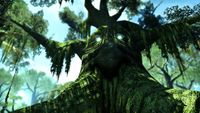
Nirn is sometimes claimed to host intelligent geology, including: trees, brooks, rocks, even mountains.[86] In Nirn, nature spirits are said to reside in all things, rocks, roots, leaves, brooks, the wind, a field of flowers, or even a swarm of Torchbugs, though their will might be difficult to perceive, even for those who know how to listen.[87] According to the Augur of the Obscure, waterfalls house a deluge of water spirits, and each individual stone has its own spirit with its own stories to tell.[88]
Nirn is said to be imbued with a wellspring of primordial energy which flows in a network via lines within the ground, described as the manner in which Druids visualize the Earthbones, places where these "bonelines" intersect are said to possess great power and have an effect on both magic and prayer performed there.[89][90][91] According to some sources, the reason Nirn is filled with natural caverns is that in primordial times they formed a network that functioned like nodes or capillaries for the divine essence of the Aedra that created it.[92]
It is said that, when a mortal dies, their memories become Water,[93] with rivers of memory even connecting Nirn to realms beyond,[94] and the oceans being described as extending beyond the three dimensions mortal senses perceive, and as having a true nature that can be fatal to witness. Nature spirits of water are said to be capable of using these rivers of memory to travel to different realms.[95] According to some sources, all waterways connect the worlds of the living and the dead, allowing spirits to observe the living and cross over from the afterlife on certain dates.[96]
The seas and oceans are often referred to singularly as the Lady Sea by the people of Tamriel,[97] or the Mother Sea by the Maormer.[98] Different gods are associated with the sea, such as Kynareth,[99] Hermaeus Mora,[100] and Vigryl.[UOL 7]
The Serpent Celestial described primordial Nirn as a place that fed on life and was nearly uninhabitable by it, claiming that civilization stifled Nirn's natural growth and progress and that the blood of Nirnian creatures, such as Trolls had "thinned" over the ages. He sought to return the world to this primordial form, which he claimed he'd achieve by waking the fire under the land, making the seas boil, and making the jungles reclaim the land from civilization under his guidance.[101][102]
Notes[edit]
- The Anuad has the feminine entity Nir, who is said to have birthed Creation.
Gallery[edit]
References[edit]
- ^ a b c d e f g The Monomyth
- ^ a b Pocket Guide to the Empire, 3rd Edition: Arena Supermundus: The Tapestry of Heaven — Imperial Geographical Society, 3E 432
- ^ a b Artorius Ponticus Answers Your Questions — Bishop Artorius Ponticus
- ^ Spirit of Nirn, God of Mortals
- ^ Varieties of Faith in the Empire — Brother Mikhael Karkuxor of the Imperial College
- ^ a b c d Before the Ages of Man — Aicantar of Shimerene
- ^ a b c d The Annotated Anuad
- ^ a b Words of Clan Mother Ahnissi — Clan Mother Ahnissi
- ^ a b c Spirits of Amun-dro — Amun-dro, the Silent Priest
- ^ The Nine Coruscations — Star-Queen Varalias
- ^ a b The Mystery of Artaeum — Penewen, Advisor to the Court
- ^ Varieties of Faith in the Empire — Brother Mikhael Karkuxor of the Imperial College
- ^ Aurbic Enigma 4: The Elden Tree — Beredalmo the Signifier
- ^ The Old Ways — Celarus the Loremaster
- ^ Lord of Souls — Greg Keyes
- ^ Great Spirits of the Reach — Vashu gra-Morga, Chief Daedrotheologist at the University of Gwylim
- ^ The Truth in Sequence — Deldrise Morvayn, Fourth Tourbillon to the Mainspring Ever-Wound
- ^ Children of the Root — Solis Aduro
- ^ the Light and the Dark — Irek Unterge
- ^ Mankar Camoran's dialogue in Oblivion
- ^ Mythic Dawn Commentaries — Mankar Camoran
- ^ The Ooze: A Fable
- ^ Brief Letter to an Aldarch in ESO
- ^ Wild Hunt Horse mount description in ESO
- ^ Wild Hunt Crate descriptions in ESO
- ^ The Voice of Ouze's dialogue in Back to Rest
- ^ a b Pocket Guide to the Empire, 3rd Edition: Other Lands — Imperial Geographical Society, 3E 432
- ^ Mysterious Akavir
- ^ Frontier, Conquest — University of Gwylim Press, 3E 344
- ^ a b Pocket Guide to the Empire, 1st Edition: The Wild Regions — Imperial Geographical Society, 2E 864
- ^ Corpse Preparation
- ^ a b Journal of Tsona-Ei — Tsona-Ei
- ^ Brief History of the Empire v 3 — Stronach k'Thojj III
- ^ Mythic Dawn Commentaries 4 — Mankar Camoran
- ^ The Lunar Lorkhan — Fal Droon
- ^ Shazah's dialogue during The Den of Lorkhaj in ESO
- ^ The Moon Cats and their Dance — Clan Mother Ahnissi
- ^ The Infernal City — Greg Keyes
- ^ The Firmament — Ffoulke
- ^ High Astrologer Caecilus Bursio Answers Your Questions — High Astrologer Caecilus Bursio
- ^ Imperial Orrery appearance in Oblivion: Orrery
- ^ a b Ithelia's dialogue in ESO: Gold Road
- ^ Hermaeus Mora's dialogue in ESO
- ^ Scruut's dialogue in ESO
- ^ Heart of Evil quest in ESO
- ^ Indaenir's dialogue in ESO
- ^ Retaking the Pass quest in ESO
- ^ The Chronicle's dialogue in ESO
- ^ Elder Pitof's dialogue in ESO
- ^ Frii's dialogue in ESO: Firesong
- ^ Druid Laurel's dialogue in ESO
- ^ Odahviing's dialogue in Skyrim
- ^ Karliah's dialogue during Darkness Returns in Skyrim
- ^ Events of To Walk on Far Shores in ESO
- ^ Keeper of the Hall's dialogue in ESO
- ^ The Doors of Oblivion — Seif-ij Hidja
- ^ Events of The Cause
- ^ Vonos' Journal — Vonos
- ^ Events of ESO: Morrowind
- ^ Count Verandis Ravenwatch's dialogue during the quest The End of Eternity in ESO
- ^ Gwendis' dialogue during the quest The Dark Heart in ESO
- ^ Haskill's dialogue in the Shivering Isles
- ^ The Remnant of Argon quest in ESO
- ^ Battlegrounds in ESO
- ^ Hunter's Grotto in ESO: Markarth
- ^ Jode's Core quest in ESO
- ^ The Indrik's dialogue in ESO: Gold Road
- ^ Leramil's dialogue during A Hidden Fate in ESO
- ^ Meln the Mouthless' dialogue during A Hidden Fate in ESO
- ^ A Hidden Fate quest in ESO
- ^ Blightcrown's dialogue in ESO
- ^ Events of Light the Dragonfires in Oblivion
- ^ Dialogue from the Drake of Blades in ESO
- ^ Trials of St. Alessia
- ^ The Sublime Brazier — Augusta Purusius, Associate Historian, Imperial Academy of Records and Histories
- ^ Martin Septim's dialogue in Oblivion
- ^ Crafting Motif 41: Celestial Style — the Guardian of Stars
- ^ Moon-Bishop Azin-jo's dialogue in ESO: Elsweyr
- ^ The Bladesongs of Boethra — Modun-Ra, the Hidden Voice
- ^ Aurbic Enigma 4: The Elden Tree — Beredalmo the Signifier
- ^ Loremaster's Archive - Mehrunes Dagon & Daedra in the Second Era — Lyranth
- ^ Vyrthur's dialogue in Skyrim
- ^ Serana's dialogue in Skyrim
- ^ Ulfsild's Notes: The Origin of Luminaries — Ulfsild
- ^ The Four Suitors of Benitah — Jole Yolivess
- ^ The Faerie — Szun Triop
- ^ Druid Ryvana's dialogue in ESO
- ^ Augur of the Obscure's dialogue in ESO
- ^ Stormweaver's Cavort codex entries in ESO: Firesong
- ^ Pearls of Ehlnofey codex entries in ESO: Markarth
- ^ Visitor's Guide to Y'ffre's Cauldron — Bernardine Gelves, Associate Chancellor of Cultural Heritage
- ^ Weeping Wind Cave loading screen in ESO
- ^ Herald Kixathi's dialogue in ESO
- ^ Vistha-Li's dialogue in ESO
- ^ Augur of the Obscure's dialogue in ESO
- ^ Domitia Nasica's dialogue in ESO
- ^ Lithnilian's Research Notes — Lithnilian
- ^ Castire's dialogue in ESO: Summerset
- ^ Light-Keeper Menoit's dialogue in ESO: High Isle
- ^ Landolvel's dialogue in ESO: Necrom
- ^ The Serpent's dialogue in ESO
- ^ The Serpent's Image encounter ESO
- ^ The Brothers of Darkness — Pellarne Assi
Note: The following references are considered to be unofficial sources. They are included to round off this article and may not be authoritative or conclusive.
- ^ a b c Michael Kirkbride's Posts
- ^ a b Nu-Mantia Intercept — Nu-Hatta, The Imperial Library
- ^ Nemon's Memorystone — Nemon
- ^ Michael Kirkbride r/teslore Ask Me Anything
- ^ a b c d e Cosmology — The Temple Zero Society
- ^ Josh Utter-Leyton Isle of Madness Interview
- ^ Daggerfall Preview
| ||||||||||||||||||||
| ||||||||||||||||||||||||||

